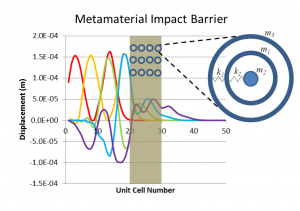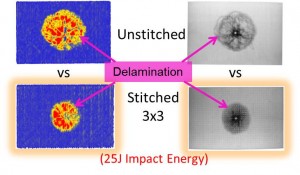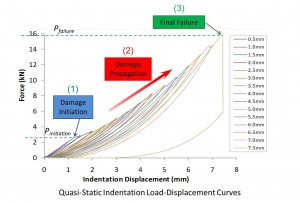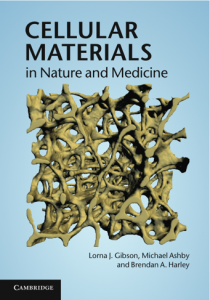Acoustic/Elastic/Mechanical Composite Metamaterials
Acoustic/elastic composite metamaterials exhibit unique properties not commonly found in natural materials. By specially designing their microstructures, these metamaterials possess negative effective mass density over certain frequency ranges. This implies that stress waves cannot be transmitted through the material, thus enabling control and attenuation of stress wave propagation. This results in interesting applications including vibration control, impact protection, blast wave mitigation and energy harvesting. Recently, we further explore and utilize the local resonance concept in mechanical metamaterials to achieve unique one-way wave transmission and control thermal conductivity.
Read the full articles:
- B. Li*, C. Zhang*, F. Peng, W. Wang, B.D. Vogt and K.T. Tan (2021). 4D Printed Shape Memory Metamaterial for Vibration Bandgap Switching and Active Elastic-Wave Guiding, Journal of Materials Chemistry C, 9: 1164-1173. DOI
- B. Li*, Y.Q. Liu and K.T. Tan (2019). A Novel Meta-Lattice Sandwich Structure for Dynamic Load Mitigation, Journal of Sandwich Structures and Materials, 21: 1880-1905. DOI
- S. Alamri*, B. Li*, G. Mchugh, N. Garafolo, K.T. Tan (2019). Dissipative Diatomic Acoustic Metamaterials for Broadband Asymmetric Elastic Wave Transmission, Journal of Sound and Vibration, 451: 120-137. DOI
- M. Jaberzadeh*, B. Li* and K.T. Tan (2019). Wave Propagation in an Elastic Metamaterial with Anisotropic Effective Mass Density, Wave Motion, 89: 131-141. DOI
- B. Li*, Z. Li, J. Christensen, and K.T. Tan (2019). Dual Dirac Cones in Elastic Lieb-like Lattice Metamaterials, Applied Physics Letters, 114: 081906. DOI
- B. Li*, K.T. Tan and J. Christensen (2018). Heat Conduction Tuning by Hyperbranched Nanophononic Metamaterials, Journal of Applied Physics, 123: 205105. DOI
- M.H. Khan*, B. Li* and K.T. Tan (2018). Impact Load Wave Transmission in Elastic Metamaterials, International Journal of Impact Engineering, 118: 50-59. DOI
- S. Alamri*, B. Li*, K.T. Tan (2018). Dynamic Load Mitigation using Dissipative Elastic Metamaterials with Multiple Maxwell-Type Oscillators, Journal of Applied Physics, 123: 095111. DOI
- B. Li*, S. Alamri* and K.T. Tan (2017). A Diatomic Elastic Metamaterial for Tunable Asymmetric Wave Transmission in Multiple Frequency Bands, Scientific Reports, 7: 6226. DOI
- B. Li*, K.T. Tan and J. Christensen (2017). Tailoring the Thermal Conductivity in Nanophononics Metamaterials, Physical Review B, 95: 144305. DOI
- B. Li* and K.T. Tan (2016). Asymmetric Wave Transmission in a Diatomic Acoustic/Elastic Metamaterial, Journal of Applied Physics, 120: 075103. DOI
- H.H. Huang, C.K. Lin and K.T. Tan (2016). Attenuation of Transverse Waves by Using a Metamaterial Beam with Lateral Local Resonators, Smart Materials and Structures, 25: 085027. DOI
- A. Qureshi*, B. Li* and K.T. Tan (2016). Numerical Investigation of Band Gaps in 3D Printed Cantilever-In-Mass Metamaterials, Scientific Reports, 6: 28314. DOI
- K.T. Tan, H.H. Huang and C.T. Sun (2014). Blast-Wave Impact Mitigation Using Negative Effective Mass Density Concept of Elastic Metamaterials, International Journal of Impact Engineering, 64: 20-29. DOI
- K.T. Tan and C.T. Sun (2013). Interactive behavior of internal resonators in acoustic metamaterials under impact pulse loading, Proceedings of Meetings on Acoustics, 19(1): 065037. DOI
- K.T. Tan, H.H. Huang and C.T. Sun (2012). Optimizing the Band Gap of Effective Mass Negativity in Acoustic Metamaterials, Applied Physics Letters, 101: 241902. DOI
Impact Damage of Advanced Composites
Advanced composite materials are hugely employed in modern aircraft structures and in many aerospace applications like engine casing, fan-blades, etc. This is attributed to their high strength-weight ratio and high stiffness-weight ratio, making composites extremely light, yet exceptionally strong. However, the use of composites makes them susceptible to impact damage, which could result in complex multi-scale failure mechanisms like delamination, matrix cracking, fiber debonding, fiber fracture, etc. Adding to that, the operating conditions of these composite parts are often at high temperature environment, thus causing the damage behavior of the material to be particularly complicated. Both state-of-the art non-destructive inspection (NDI) experimental techniques and muti-scale modelling methodology are utilized in this work, with the aim to explore strategies to improve the impact damage tolerance of composites. Recently, we explore the impact behavior of advanced composites in extreme low temperature arctic environment.
Read the full articles:
- A. Banik*, C. Zhang*, D. Panyathong* and K.T. Tan (2022). Effect of Equienergetic Low-Velocity Impact on CFRP with Surface Ice in Low Temperature Arctic Conditions, Composites Part B: Engineering, 236: 109850. DOI
- A. Banik*, C. Zhang*, M.H. Khan*, M. Wilson* and K.T. Tan (2022). Low-Velocity Ice Impact Response and Damage Phenomena on Steel and CFRP Sandwich Composite, International Journal of Impact Engineering, 162: 104134. DOI
- M. Elamin*, B. Li* and K.T. Tan (2021). Compression After Impact Performance of Carbon-Fiber Foam-Core Sandwich Composites in Low Temperature Arctic Conditions, Composite Structures, 261: 113568. DOI
- M.H. Khan*, B. Li* and K.T. Tan (2020). Impact Performance and Bending Behavior of Carbon-Fiber Foam-Core Sandwich Composite Structures in Cold Arctic Temperature, Journal of Composites Science, 4: 133. DOI
- M.H. Khan* and K.T. Tan (2020). Post-Impact Flexural Collapse Modes of Composite Sandwich Structures in Arctic Conditions: Analytical Prediction and Experimental Validation, Composites Science and Technology, 195: 108187. DOI
- C. Zhang* and K.T. Tan (2020). Low-Velocity Impact Response and Compression After Impact Behavior of Tubular Composite Sandwich Structures, Composites Part B: Engineering, 193: 108026. DOI
- M.H. Khan*, M. Elamin*, B. Li* and K.T. Tan (2018). X-ray Micro-Computed Tomography Analysis of Impact Damage Morphology in Composite Sandwich Structures due to Cold Temperature Arctic Condition, Journal of Composite Materials, Special Issue on Impact and Dynamic Response ASC2017, 52: 3509-3522. DOI
- D.R. Cross*, K.T. Tan, E.J. Pineda, B.A. Bednarcyk and S.M. Arnold (2018). Multiscale Modeling of Carbon Fiber Reinforced Polymer Composites in Low Temperature Arctic Conditions, Multiscale and Multidisciplinary Modeling, Experiments and Design, Special Issue on Composite Materials and Structures for Marine Applications, published online: 1: 239-254. DOI
- M. Elamin*, B. Li* and K.T. Tan (2018). Impact Damage of Composite Sandwich Structures in Arctic Condition, Composite Structures, 192: 422-433. DOI
- K.T. Tan, A. Yoshimura, N. Watanabe, Y. Iwahori and T. Ishikawa (2015). Further Investigation of Delamination Reduction Trend for Stitched Composites, Composites Science and Technology, 118: 141-153. DOI
- K.T. Tan, N. Watanabe, Y. Iwahori and T. Ishikawa (2012). Understanding Effectiveness of Stitching in Suppression of Impact Damage: An Empirical Delamination Reduction Trend for Stitched Composites, Composites Part A: Applied Science and Manufacturing, 43: 823-832. DOI
- K.T. Tan, N. Watanabe, Y. Iwahori and T. Ishikawa (2012). Effect of Stitch Density and Stitch Thread Thickness on Compression After Impact Strength and Response of Stitched Composites, Composites Science and Technology, 72: 587-598. DOI
- K.T. Tan, N. Watanabe and Y. Iwahori (2012). Impact Damage Resistance, Response and Mechanisms of Laminated Composites Reinforced by Through-Thickness Stitching, International Journal of Damage Mechanics, 21(1):51-80. DOI
- K.T. Tan, N. Watanabe and Y. Iwahori (2011). X-ray Radiography and micro Computed Tomography Examination of Damage Characteristics in Stitched Composites subjected to Impact Loading, Composites Part B: Engineering, 42: 874-884. DOI
- K.T. Tan, N. Watanabe and Y. Iwahori (2010). Effect of Stitch Density and Stitch Thread Thickness on Low-Velocity Impact Damage of Stitched Composites, Composites Part A: Applied Science and Manufacturing, 41: 1857-1868. DOI
Fracture & Damage of Composites with Interlaminar Reinforcement
Interlaminar reinforcement technique, like stitching, can effectively increase the generally poor interlaminar strength of laminated composites. Stitching increases the delamination resistance by reducing the crack opening displacement in mode I loading and resisting crack sliding displacement in mode II. Bridging forces offered by stitches significantly increase the ultimate strength of the material through high energy absorption in fibre fracture and frictional pull-out. Novel experimental techniques are used to investigate the fracture behavior of single stitch fiber, which is subsequently employed to develop a stitch progressive damage model. Damage phenomenon, incorporating the effect of stitching, is elucidated.
Read the full articles:
- M. Elamin*, B. Li* and K.T. Tan (2018). Impact Performance of Stitched and Unstitched Composites in Extreme Low Temperature Arctic Conditions, Journal of Dynamic Behavior of Materials, Special Issue on Dynamic Failure of Composite Materials, 4: 317-327. DOI
- K.T. Tan, N. Watanabe and Y. Iwahori (2015). Finite Element Model for Compression After Impact Behaviour of Stitched Composites, Composites Part B: Engineering, 79: 53-60. DOI
- K.T. Tan, A. Yoshimura, N. Watanabe, Y. Iwahori and T. Ishikawa (2013). Effect of Stitch Density and Stitch Thread Thickness on Damage Progression and Failure Characteristics of Stitched Composites under Out-Of-Plane Loading, Composites Science and Technology, 74: 194-204. DOI
- K.T. Tan, N. Watanabe and Y. Iwahori (2011). Stitch Fibre Comparison for Improvement of Interlaminar Fracture Toughness in Stitched Composites, Journal of Reinforced Plastics and Composites, 30(2): 99-109. DOI
- K.T. Tan, N. Watanabe, Y. Iwahori, H. Hoshi and M. Sano (2010). Interlaminar Fracture Toughness of Vectran-Stitched Composites – Experimental and Computational Analysis, Journal of Composite Materials, 44(26): 3203-3229. DOI
- K.T. Tan, N. Watanabe and Y. Iwahori (2010). Experimental Investigation of Bridging Law for Single Stitch Fibre using Interlaminar Tension Test, Composite Structures, 92: 1399-1409. DOI
Biomimetic Structures for Impact Protection
The concept of biomimicry is solving problems and creating new opportunities through understanding and applying biological models. Very often, innovation inspired by nature and careful examination of the natural world are potential ways to seek solution to real-world problems. In this work, we seek inspiration from nature to design and recreate biomimetic, damage tolerant structures that are highly effective in absorbing impact shock load. Both computational and experimental techniques are utilized to fundamentally understand the mechanics of hierarchical structural members with cellular materials to attain high strength-weight ratio and to achieve extraordinary mechanical performance and exceptional impact response.
Read the full articles:
- K. Asakawa, Y. Hirano, K.T. Tan and T. Ogasawara (2024). Bio-inspired Study of Stiffener Arrangements in Composite Stiffened Panels using the Voronoi Diagram as an Indicator, Composite Structures, 327: 117640. DOI
- I. Kaiser*, C. Tan* and K.T. Tan (2021). Bio-inspired Patterned Adhesive Single-Lap Joints for CFRP and Titanium, Composites Part B: Engineering, 224: 109182. DOI
- A. Banik* and K.T. Tan (2020). Dynamic Friction Performance of Hierarchical Biomimetic Surface Pattern Inspired by Frog Toe-Pad, Advanced Materials Interfaces, 7: 2000987. DOI
- C. Drol*, E.B. Kennedy*, B.K. Hsiung*, N.B. Swift* and K.T. Tan (2019). Bioinspirational Understanding of Flexural Performance in Hedgehog Spines, Acta Biomaterialia, 94: 553-564. DOI
- C. Rice* and K.T. Tan (2019). Horse Hoof Inspired Biomimetic Structure for Improved Damage Tolerance and Crack Diversion, Composite Structures, 220: 362-270. DOI
- E.B. Kennedy*, B.K. Hsiung*, N.B. Swift* and K.T. Tan (2017). Static Flexural Properties of Hedgehog Spines Conditioned in Coupled Temperature and Relative Humidity Environments, Journal of the Mechanical Behavior of Biomedical Materials, 75: 413-422. DOI
- Featured report on Inverse. Read it here.
- N.B. Swift*, B.K. Hsiung*, E.B. Kennedy* and K.T. Tan (2016). Dynamic Impact Testing of Hedgehog Spines using a Dual-Arm Crash Pendulum, Journal of the Mechanical Behavior of Biomedical Materials, 61: 271-282. DOI
Adhesive Joints and Patterned Surfaces

Adhesive joints are important to adhere different kinds of materials to provide an overall strong structural performance. One approach is to design patterned surfaces to improve mechanical strength and control failure mechanisms. In this work, we employ both experimental and numerical approaches to design and characterize composite adhesive joints to understand the mechanics of adhesive, adherend and cohesive failure. We also utilize the concept of biomimicry to design patterned surfaces for improved dynamic traction and strong adhesive bonds.
Read the full articles:
- I. Kaiser*, N. Richards*, T. Ogasawara and K.T. Tan (2023). Machine Learning Algorithms for Deeper Understanding and Better Design of Composite Adhesive Joints, Materials Today Communications, 34: 105428. DOI
- I. Kaiser*, C. Zhang* and K.T. Tan (2022). Mechanical Behavior and Failure Mechanisms of CFRP and Titanium Tubular Adhesive Lap Joints at Extreme Temperatures, Composite Structures, 290: 115528. DOI
- M.G. Rasul, A. Kiziltas, M.S.B. Hoque, A. Banik*, P.E. Hopkins, K.T. Tan, B. Arfaei, R. Shahbazian-Yassar (2022). Improvement of the Thermal Conductivity and Tribological Properties of Polyethylene by Incorporating Functionalized Boron Nitride Nanosheets, Tribology International, 165: 107277. DOI
- I. Kaiser*, C. Tan* and K.T. Tan (2021). Bio-inspired Patterned Adhesive Single-Lap Joints for CFRP and Titanium, Composites Part B: Engineering, 224: 109182. DOI
- I. Kaiser* and K.T. Tan (2020). Damage and Strength Analysis of Carbon Fiber Reinforced Polymer and Titanium Tubular-Lap Joint using Hybrid Adhesive Design, International Journal of Adhesion and Adhesives, 103: 102710. DOI
- A. Banik* and K.T. Tan (2020). Dynamic Friction Performance of Hierarchical Biomimetic Surface Pattern Inspired by Frog Toe-Pad, Advanced Materials Interfaces, 7: 2000987. DOI
- S. Oshima, A. Yoshimura, Y. Hirano, T. Ogasawara and K.T. Tan (2019). In-Situ Observation of Microscopic Damage in Adhesively Bonded CFRP Joints Under Mode I and Mode II Loading, Composite Structures, 227: 111330. DOI
* denote students in K.T. Tan’s Research Group




